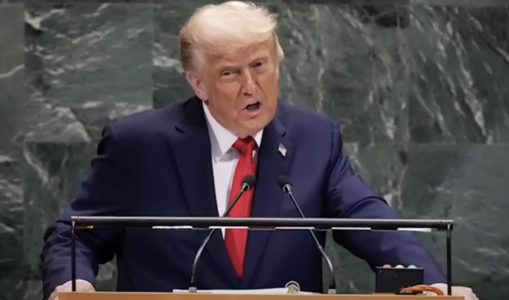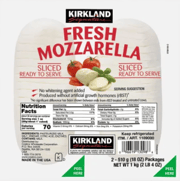Could tariff checks really land in your mailbox? Here's what to know about the $1,000–$2,000 proposal
By
Veronica E.
- Replies 0
If you’ve heard talk about a new kind of stimulus check—this time backed by tariffs instead of pandemic relief—you’re not alone in wondering whether it’s fact or fiction.
The idea of receiving $1,000 or even $2,000 from the government has sparked curiosity, especially among those already managing tight budgets.
But is this proposal grounded in reality, or is it just another headline-grabbing promise during an election year?
With so many rumors floating around, it’s important to understand where this idea came from, what’s fueling the buzz, and whether everyday Americans might actually see any money.
Let’s take a closer look at how tariff revenue is involved, what legal and political barriers stand in the way, and what you should do to stay financially secure in the meantime.

What are "tariff-funded" stimulus checks?
The concept stems from President Donald Trump, who recently suggested that the federal government could send direct payments to Americans—ranging from $1,000 to $2,000—using revenue collected from tariffs on imported goods.
So far in 2025, the US Department of the Treasury has brought in more than $214 billion through tariffs, including over $31 billion in September alone.
Tariffs are essentially taxes paid by companies when they bring products into the country.
Trump’s idea is to take a portion of that revenue and return it to Americans as a kind of “dividend.”
In theory, it’s a way to reward citizens while still maintaining tough trade policies.
But in practice, things aren’t so straightforward.
Also read: Retailers scramble to keep prices steady amid tariff pressure: Are shoppers the ones who pay?
Why this stimulus idea stands apart
This isn’t the first time direct payments have been proposed—pandemic-era stimulus checks are still fresh in many people’s memories.
However, this proposal differs in a few important ways. It’s not tied to an emergency or recession.
Instead, it would be based on tariff earnings, which are already factored into the broader federal budget.
Earlier in the year, President Trump also mentioned something called the “DOGE dividend”—a nickname for a plan to return 20% of tariff revenue to taxpayers.
Despite the flashy name (and no connection to cryptocurrency), the plan lacked specifics, and no checks were ever issued.
Also read: Tariff plan paused—Trump steps back after market chaos shakes investors
Is it a real plan—or campaign politics?
There are three major obstacles standing between this idea and your mailbox:
1. Legal challenges
A case currently under review by the Supreme Court questions whether a president even has the legal authority to impose these tariffs.
A lower court has already ruled that Trump may have exceeded his powers.
If the Court ultimately strikes down these tariffs, the entire stimulus proposal could collapse, along with its funding source.
2. Economic doubts
Tax professionals and economists are skeptical about the math.
While billions have been collected, experts like tax strategist Armine Alajian warn that the funds likely aren’t sufficient to issue large checks without affecting other parts of the federal budget.
In short, the numbers might not add up.
3. Political timing
With the 2024 election cycle underway, proposals like these often make headlines but stall out in Congress.
Passing legislation to send out checks would require bipartisan agreement—something that remains unlikely with legal battles still playing out.
Also read: New US tariff on Mexican tomatoes marks shift toward domestic production
Just how much money is available?
The Treasury has reported the following monthly tariff collections in 2025:
While these figures are substantial, dividing that amount among 330+ million Americans would significantly reduce the value of any individual payment.
Additionally, much of that money is already budgeted for existing government programs.
Also read: Trade tensions rise between US and Canada—tariff decisions pending
What should you expect right now?
At the moment, there is no formal program in place—no website, no sign-up, no timeline.
The idea remains a proposal, and significant legal, political, and financial hurdles must be cleared before it becomes a reality.
Experts strongly advise against making financial plans around this idea until there’s clear movement from Congress or the Treasury.
Also read: Slash your grocery bill now: 5 smart swaps to outsmart rising tariff costs!
What you can do today
Even without an official stimulus check on the horizon, there are a few things you can do to stay protected and informed:
How tariffs may affect your wallet in other ways
While the concept of a “tariff dividend” has generated interest, it’s worth noting that tariffs can also influence consumer prices—particularly on imported items such as clothing, electronics, and food.
Some analysts estimate that certain tariffs may have contributed to increased household expenses in recent years, including higher grocery costs.
As discussions continue around how tariff revenue might be used, it’s helpful to consider both the potential benefits and broader economic impacts of these trade policies.
Read next:

Do you think Americans should receive direct payments funded by tariffs? Have you noticed higher prices in your household due to trade policies? Or are you more concerned with how the money is used elsewhere? Share your thoughts with us—we’re here to listen.
The idea of receiving $1,000 or even $2,000 from the government has sparked curiosity, especially among those already managing tight budgets.
But is this proposal grounded in reality, or is it just another headline-grabbing promise during an election year?
With so many rumors floating around, it’s important to understand where this idea came from, what’s fueling the buzz, and whether everyday Americans might actually see any money.
Let’s take a closer look at how tariff revenue is involved, what legal and political barriers stand in the way, and what you should do to stay financially secure in the meantime.

Many Americans are hopeful about the idea of a new stimulus check, but experts say it's best to stay informed—and cautious—as the proposal unfolds. Image Source: YouTube / Fox News Clips.
What are "tariff-funded" stimulus checks?
The concept stems from President Donald Trump, who recently suggested that the federal government could send direct payments to Americans—ranging from $1,000 to $2,000—using revenue collected from tariffs on imported goods.
So far in 2025, the US Department of the Treasury has brought in more than $214 billion through tariffs, including over $31 billion in September alone.
Tariffs are essentially taxes paid by companies when they bring products into the country.
Trump’s idea is to take a portion of that revenue and return it to Americans as a kind of “dividend.”
In theory, it’s a way to reward citizens while still maintaining tough trade policies.
But in practice, things aren’t so straightforward.
Also read: Retailers scramble to keep prices steady amid tariff pressure: Are shoppers the ones who pay?
Why this stimulus idea stands apart
This isn’t the first time direct payments have been proposed—pandemic-era stimulus checks are still fresh in many people’s memories.
However, this proposal differs in a few important ways. It’s not tied to an emergency or recession.
Instead, it would be based on tariff earnings, which are already factored into the broader federal budget.
Earlier in the year, President Trump also mentioned something called the “DOGE dividend”—a nickname for a plan to return 20% of tariff revenue to taxpayers.
Despite the flashy name (and no connection to cryptocurrency), the plan lacked specifics, and no checks were ever issued.
Also read: Tariff plan paused—Trump steps back after market chaos shakes investors
Is it a real plan—or campaign politics?
There are three major obstacles standing between this idea and your mailbox:
1. Legal challenges
A case currently under review by the Supreme Court questions whether a president even has the legal authority to impose these tariffs.
A lower court has already ruled that Trump may have exceeded his powers.
If the Court ultimately strikes down these tariffs, the entire stimulus proposal could collapse, along with its funding source.
2. Economic doubts
Tax professionals and economists are skeptical about the math.
While billions have been collected, experts like tax strategist Armine Alajian warn that the funds likely aren’t sufficient to issue large checks without affecting other parts of the federal budget.
In short, the numbers might not add up.
3. Political timing
With the 2024 election cycle underway, proposals like these often make headlines but stall out in Congress.
Passing legislation to send out checks would require bipartisan agreement—something that remains unlikely with legal battles still playing out.
Also read: New US tariff on Mexican tomatoes marks shift toward domestic production
Just how much money is available?
The Treasury has reported the following monthly tariff collections in 2025:
- January: $8.96 billion
- February: $8.93 billion
- March: $9.61 billion
- April: $17.43 billion
- May: $23.96 billion
- June: $28.02 billion
- July: $29.63 billion
- August: $31.4 billion
- September: $31.3 billion
While these figures are substantial, dividing that amount among 330+ million Americans would significantly reduce the value of any individual payment.
Additionally, much of that money is already budgeted for existing government programs.
Also read: Trade tensions rise between US and Canada—tariff decisions pending
What should you expect right now?
At the moment, there is no formal program in place—no website, no sign-up, no timeline.
The idea remains a proposal, and significant legal, political, and financial hurdles must be cleared before it becomes a reality.
Experts strongly advise against making financial plans around this idea until there’s clear movement from Congress or the Treasury.
Also read: Slash your grocery bill now: 5 smart swaps to outsmart rising tariff costs!
What you can do today
Even without an official stimulus check on the horizon, there are a few things you can do to stay protected and informed:
- Watch for news updates
Keep an eye on reliable outlets for announcements from the Treasury or decisions from the Supreme Court. - Stay alert for scams
Whenever stimulus checks are in the news, scammers often try to take advantage. Never share your Social Security number, banking details, or personal information with anyone claiming to help you “claim your check.” - Make practical financial plans
It’s best to continue budgeting based on your current income and benefits, rather than relying on speculative government proposals.
How tariffs may affect your wallet in other ways
While the concept of a “tariff dividend” has generated interest, it’s worth noting that tariffs can also influence consumer prices—particularly on imported items such as clothing, electronics, and food.
Some analysts estimate that certain tariffs may have contributed to increased household expenses in recent years, including higher grocery costs.
As discussions continue around how tariff revenue might be used, it’s helpful to consider both the potential benefits and broader economic impacts of these trade policies.
Read next:
- The economy is flashing warning signs—and Trump’s tariff policy may be to blame
- Are rebate checks making a comeback? President Trump signals support for new payouts
- Several Trump tariffs are back—for now. Here’s what that means for prices and trade
Key Takeaways
- A proposal from President Trump would use tariff revenue to send $1,000–$2,000 checks to Americans.
- Over $214 billion has been collected in tariffs this year, but legal challenges and budget limitations may block the idea.
- There is currently no active program or application process, and experts caution against counting on a payout.
- Tariffs may already be costing American households more through higher prices, which could outweigh any proposed dividend.
Do you think Americans should receive direct payments funded by tariffs? Have you noticed higher prices in your household due to trade policies? Or are you more concerned with how the money is used elsewhere? Share your thoughts with us—we’re here to listen.






